Key Takeaways
- The 1970s disco era was a time of bold, vibrant colors and shimmering accents
- Disco fashion embraced metallics, sequins, and glitter for a dazzling nightlife look
- Colors like hot pink, electric blue, and bright yellow dominated disco style
- Disco inspired psychedelic patterns and color combinations on clothing and decor
- Disco makeup featured dramatic eyes, flushed cheeks, and glossy lips in vivid hues
- Disco hairstyles incorporated colorful streaks and glitter for extra sparkle
- The disco aesthetic extended beyond fashion into art, music, and pop culture
- Today’s fashion and design still draw inspiration from the iconic disco era colors
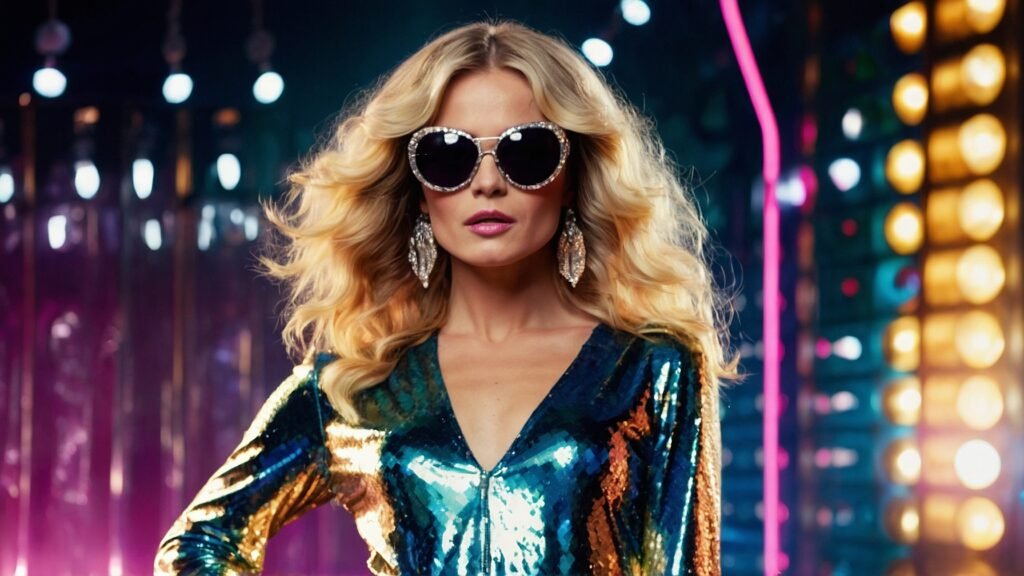
The pulsating beats of disco music, dazzling dance floor lights, and shimmering silhouettes moving in perfect sync defined the unforgettable disco era of the 1970s. This iconic time in music history saw fashion and culture boldly embrace vibrant colors, metallic fabrics, and an exuberant energy that lit up nightlife scenes. The electric shades of disco fever—from glimmering golds and silvers to neon hues—left a lasting impact on 1970s fashion, pop culture, and art, making disco style a timeless influence in the world of nightlife and retro trends.
In this article, we’ll embark on a journey through the shimmering shades of the 70s, exploring the vibrant colors, dazzling textures, and iconic styles that defined the disco era. Get ready to be transported back to a time when fashion knew no bounds and self-expression reigned supreme.
The Vibrant Palette of Disco Fever
The disco era was a vibrant explosion of color, defined by vivid and daring hues that set the tone for 1970s fashion and nightlife. Hot pinks, electric blues, and bright yellows were signature colors of disco style, dominating everything from dance floor outfits to club décor. These bold shades were frequently combined with shimmering metallics, creating eye-catching contrasts that became iconic in disco culture and demanded attention both on and off the dance floor.
Metallics and Shimmering Accents
One of the defining elements of disco fashion was the liberal use of metallics and shimmering accents. Sequins, glitter, and metallic fabrics adorned everything from dresses and jumpsuits to platform shoes and accessories. The disco ball, a quintessential symbol of the era, cast a mesmerizing glow on the dance floor, reflecting the sparkle and shine of the partygoers’ outfits.
The appeal of metallics went far beyond disco fashion, influencing disco makeup trends with shimmering eyeshadows, iridescent highlighters, and high-shine lip glosses that reflected light for a dazzling effect. Iconic disco hairstyles were often finished with sparkling glitter hairspray and bold, colorful streaks, adding extra glamour and personal flair to the signature disco style.
Psychedelic Patterns and Bold Combinations
The disco era was not just about bold, solid colors; it was also a time of experimentation with psychedelic patterns and daring color combinations. Swirling, kaleidoscopic prints in a myriad of hues adorned flowing maxi dresses and form-fitting jumpsuits, creating a mesmerizing visual effect on the dance floor.
Clashing colors that would typically be considered unconventional were celebrated in disco fashion, with neon greens paired with vibrant oranges, and electric blues complemented by shocking pinks. These bold combinations defied traditional fashion rules, reflecting the spirit of freedom and self-expression that permeated the disco scene.
Disco Fever in Fashion and Style
The disco era was a time when fashion took center stage, and the vibrant colors and shimmering textures of the period’s styles left an indelible mark on the world of fashion. From the iconic disco dress to the statement-making platform shoes, every aspect of disco fashion celebrated excess, glamour, and an unapologetic embrace of self-expression.
The Iconic Disco Dress
No iconic disco outfit was complete without the essential disco dress. These glamorous dresses, designed for the dance floor, were typically made from eye-catching fabrics such as shimmering lurex, glossy satin, or stretch velvet, all chosen for their figure-hugging, flattering fit. Popular disco dress styles featured bold colors like hot pink, electric blue, and vibrant purple, making them stand out at any disco party. Intricate cutouts, plunging necklines, and daring hemlines further enhanced the allure of these fashionable 1970s disco dresses.
Embellishments like sequins, beads, and metallic appliques adorned these dresses, creating a mesmerizing play of light and movement on the dance floor. The disco dress was not just a fashion statement; it was a celebration of confidence, sensuality, and the freedom to express oneself through bold and unapologetic style choices.
Disco Diva Accessories
No disco diva was complete without a fabulous array of accessories to complement her dazzling outfit. Platform shoes, with their towering heels and often adorned with glitter or metallic finishes, were a must-have for any disco devotee. These statement shoes added height and drama to every ensemble, allowing the wearer to strut their stuff on the dance floor with confidence.
Oversized hoop earrings, chunky bangles, and bold necklaces were also essential accessories for the disco look. These pieces were often crafted from shimmering metals or adorned with vibrant gemstones, adding a touch of opulence and glamour to any outfit. Disco fashion embraced excess, and the accessories of the era reflected this ethos, with each piece vying for attention and making a bold, unapologetic statement.
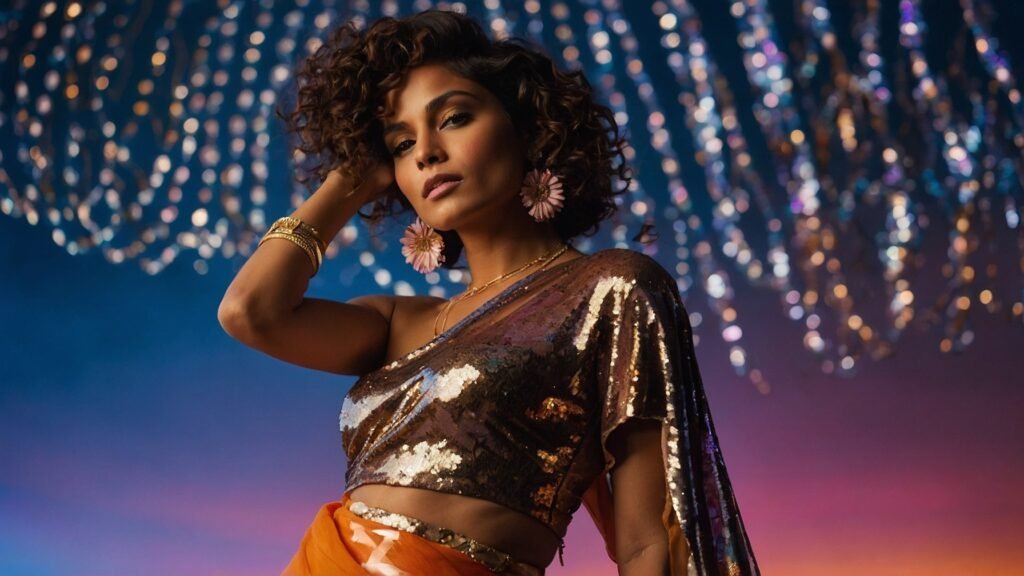
The Disco Grooming Revolution
Disco fashion extended beyond just clothing and accessories; it also influenced grooming and beauty trends of the era. Hairstyles became more daring and expressive, with voluminous curls, feathered layers, and colorful streaks taking center stage.
Makeup also underwent a revolution during the disco era, with a focus on dramatic eyes, flushed cheeks, and glossy lips in vibrant hues. Bold, colorful eyeshadows and shimmering highlights were applied with a heavy hand, creating a striking and unforgettable look that complemented the vibrant disco aesthetic.
- Glittery hair gel and hairspray for added shimmer
- False eyelashes and dramatic winged eyeliner
- Metallic nail polish in shades of gold, silver, and bronze
- Colorful wigs and hair extensions for a daring new look
- Bronzing powders and shimmering highlighters for a sun-kissed glow
- Glossy lip colors in bold reds, pinks, and plums
- Disco-inspired body glitter and shimmering body oils
- Feathered haircuts and voluminous blowouts
- Vibrant eye shadow palettes with neon and metallic shades
- Glittery makeup setting sprays for a long-lasting disco glow
Disco Fever Beyond Fashion
The influence of the disco era extended far beyond the realm of fashion and style. The vibrant colors and shimmering aesthetics of the 70s permeated various aspects of popular culture, leaving an indelible mark on art, music, and interior design.
In the world of art, the disco era inspired a new wave of artists who embraced bold, vibrant hues and experimented with unconventional materials and techniques. Andy Warhol’s iconic pop art pieces, with their vibrant colors and commentary on consumer culture, became a symbol of the era’s embrace of excess and self-expression.
The disco music scene was equally influenced by the vibrant colors and energy of the time. Album covers and concert posters featured eye-catching designs that incorporated psychedelic patterns, neon hues, and shimmering accents, reflecting the pulsating beats and infectious rhythms of the music itself.
Interior design during the disco era was a celebration of opulence and glamour. Homes and nightclubs alike were adorned with mirrored surfaces, plush velvet furnishings, and bold, contrasting color schemes. Shades of purple, fuchsia, and gold were prominently featured, creating a luxurious and indulgent atmosphere that perfectly captured the spirit of the disco lifestyle.
The disco era’s influence even extended to the world of sports and leisure. Roller skating rinks and bowling alleys embraced the vibrant hues and shimmering accents of the time, with neon lights, colorful carpets, and disco balls adorning their spaces. These recreational venues became havens for self-expression and celebration, embodying the carefree and exuberant spirit of the disco era.
As the decades passed, the legacy of the disco era’s vibrant colors and shimmering aesthetics remained a source of inspiration for fashion designers, artists, and pop culture enthusiasts alike. Today, elements of disco style can be seen in contemporary fashion trends, with metallic accents, bold color combinations, and a celebration of individuality and self-expression.
Moreover, the disco era’s influence on art and design has been the subject of numerous exhibitions and retrospectives, showcasing the enduring impact of this iconic period. From fashion retrospectives to art installations, the shimmering shades of the 70s continue to captivate audiences and inspire new generations of creatives.

The Enduring Legacy of Disco Colors
While the disco era may have faded into the annals of history, its vibrant colors and shimmering aesthetics continue to leave an indelible mark on contemporary fashion, art, and pop culture. The bold and unapologetic spirit of self-expression that characterized the 70s disco scene remains a source of inspiration for generations to come, reminding us to embrace our individuality and celebrate the power of color and creativity.
Disco Revival in Contemporary Fashion
In recent years, the fashion world has experienced a renaissance of disco-inspired styles, with designers paying homage to the iconic era through bold color choices and shimmering textures. Metallics, sequins, and glitter have made a triumphant return, adorning everything from evening gowns to streetwear.
Designers have taken inspiration from the disco era’s daring color combinations, pairing electric blues with vibrant pinks and incorporating psychedelic patterns into their collections. This revival of disco aesthetics reflects a renewed appreciation for self-expression and a celebration of individuality through fashion.
Disco Influences in Art and Design
The disco era’s impact on art and design continues to resonate today, with contemporary artists and designers drawing inspiration from the vibrant colors and shimmering textures of the 70s. Installations featuring mirrored surfaces, neon lights, and bold color palettes pay homage to the disco aesthetic, while also exploring new interpretations and concepts.
In interior design, the opulence and glamour of the disco era have found a modern revival, with velvet furnishings, metallic accents, and bold color schemes adorning homes and commercial spaces alike. This fusion of contemporary elements with disco-inspired aesthetics creates a unique and captivating ambiance that celebrates the enduring appeal of the era’s shimmering shades.
Pop Culture and Media Nostalgia
The disco era’s influence extends beyond fashion and art, as pop culture and media continue to be influenced by the iconic period. Television shows, movies, and music videos frequently draw inspiration from the vibrant colors and shimmering textures of the 70s, paying homage to the era’s unique style and cultural significance.
Music festivals and live performances also embrace the disco aesthetic, with performers adorned in shimmering costumes and stages bathed in neon lights and psychedelic projections. These contemporary interpretations of disco fever keep the spirit of the era alive, reminding audiences of the joy, freedom, and self-expression that defined the 70s dance culture.
Disco Fever: A Catalyst for Self-Expression
At its core, the disco era represented a cultural shift towards embracing self-expression, individuality, and the celebration of diversity. The vibrant colors, shimmering textures, and daring fashion choices of the time were not merely aesthetic trends; they were a reflection of a society that was beginning to challenge traditional norms and embrace a more inclusive and liberated way of life.
The dance floors of disco clubs became safe havens for marginalized communities, where people of different backgrounds, sexual orientations, and identities could come together and express themselves freely through music, dance, and fashion. The bold colors and shimmering accents of disco style became a form of self-affirmation, a way to showcase one’s unique identity and reject societal expectations.
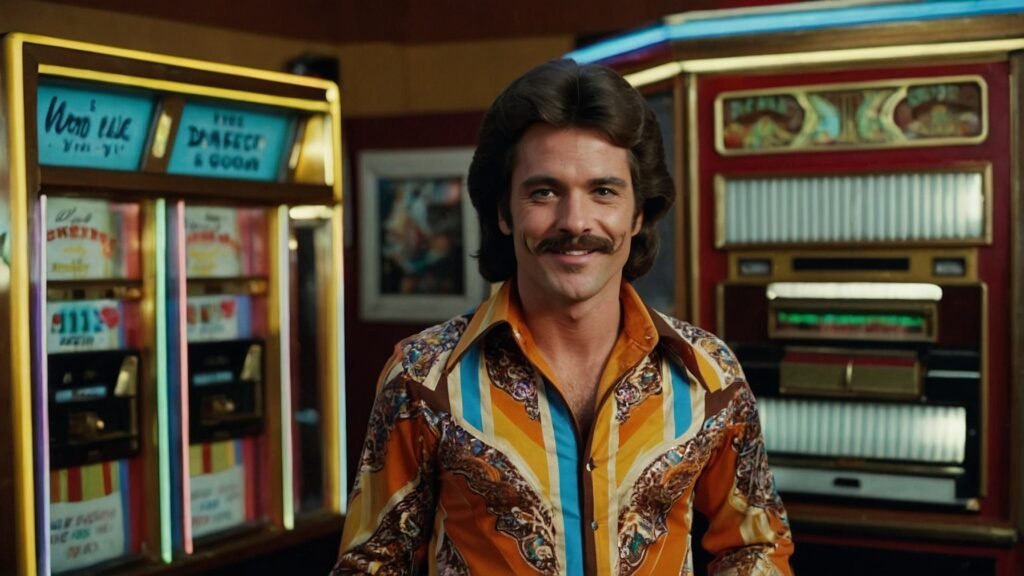
The Resurgence of Disco Fever
As the world continues to evolve and embrace inclusivity, diversity, and self-expression, the vibrant colors and shimmering aesthetics of the disco era have experienced a resurgence in popularity. Contemporary artists, designers, and fashion enthusiasts have rediscovered the joy and empowerment that comes from embracing bold hues and shimmering textures, drawing inspiration from the iconic styles of the 70s.
This revival of disco fever is not merely a nostalgic nod to the past; it is a celebration of the enduring spirit of self-expression and individuality that defined the era. Whether it’s through fashion, music, art, or interior design, the shimmering shades of the disco era continue to inspire and empower people to embrace their unique identities and reject societal constraints.
- Disco-inspired fashion shows and runway events
- Retro disco-themed parties and events
- Contemporary art installations featuring neon lights and mirrored surfaces
- Interior design trends incorporating velvet furnishings and metallic accents
- Music festivals and concerts with disco-inspired stage designs and performances
- Collaborations between fashion designers and LGBTQ+ artists and activists
- Body-positive campaigns and initiatives inspired by disco’s embrace of diverse body types
- Disco-themed makeup collections and beauty products
- Documentary films and retrospectives exploring the cultural impact of the disco era
- Efforts to preserve and restore iconic disco venues and landmarks
- Social media campaigns celebrating the self-expression and individuality of the disco era
- Educational programs and workshops on the history and significance of disco culture
- Charitable initiatives supporting LGBTQ+ organizations and causes
- Disco-inspired fashion and accessory lines for all body types and genders
Summary Table
| Color/Element | Symbolism | Significance |
|---|---|---|
| Hot Pink | Boldness, Confidence | Embodied the spirit of self-expression and unapologetic style |
| Electric Blue | Energy, Vibrancy | Represented the pulsating beats and infectious rhythms of disco music |
| Bright Yellow | Joy, Optimism | Captured the carefree and exuberant atmosphere of the disco era |
| Metallics | Glamour, Opulence | Reflected the indulgent and luxurious lifestyle of the disco scene |
| Sequins | Shine, Sparkle | Added a dazzling and mesmerizing effect to disco fashion |
| Glitter | Celebration, Extravagance | Embodied the over-the-top and exuberant spirit of disco fever |
Conclusion
The shimmering shades of the disco era represent more than just a fleeting fashion trend; they symbolize a cultural shift towards self-expression, inclusivity, and the celebration of individuality. The bold colors, shimmering textures, and daring styles of the 70s challenged traditional norms and empowered marginalized communities to embrace their authentic selves without fear or judgment.
As we continue to strive for a more diverse and accepting world, the enduring legacy of the disco era reminds us of the power of self-love and self-acceptance and the transformative impact that bold fashion choices can have on individual and societal perceptions.
Whether through contemporary fashion, art, or pop culture, the vibrant hues and shimmering accents of disco fever will continue to inspire generations to come, igniting a spirit of freedom, joy, and unapologetic self-expression.
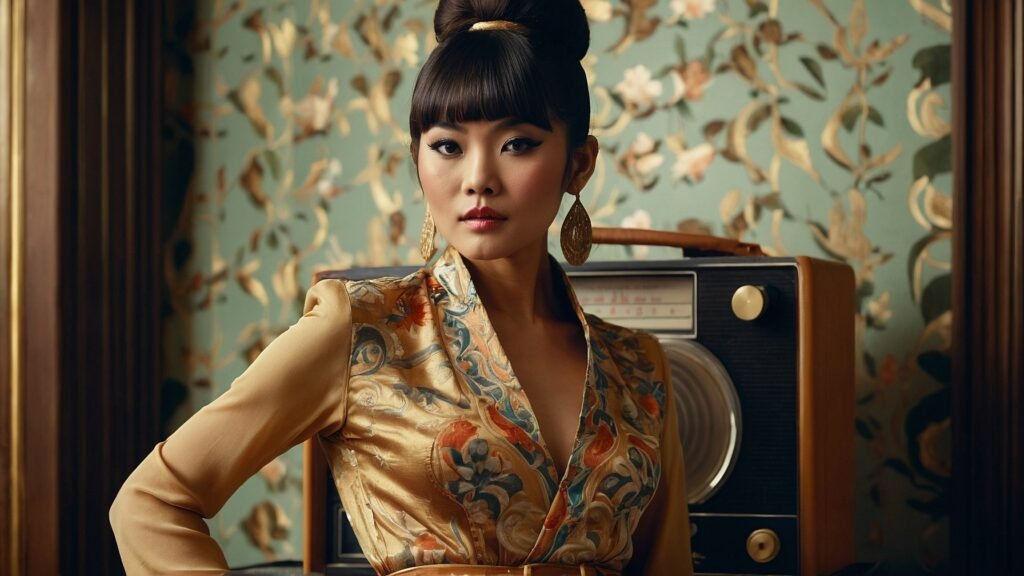
Frequently Asked Questions
What were the most iconic colors of the disco era?
The disco era was dominated by bold, vibrant colors like hot pink, electric blue, and bright yellow.
These hues were often paired with shimmering metallics, sequins, and glitter to create a dazzling and eye-catching look. Additionally, psychedelic patterns and daring color combinations, such as neon greens with vibrant oranges or shocking pinks with electric blues, were celebrated in disco fashion.
How did disco fashion incorporate metallic and shimmering elements?
Metallics and shimmering accents were a defining element of disco fashion.
Sequins, glitter, and metallic fabrics adorned everything from dresses and jumpsuits to platform shoes and accessories. Disco makeup also embraced shimmering eyeshadows, iridescent highlighters, and glossy lip glosses that captured the light in a dazzling display.
Hairstyles were adorned with glittering hairspray and colorful streaks, adding an extra touch of glamour and individuality to the disco look.
What inspired the bold color combinations and psychedelic patterns of the disco era?
The disco era was a time of experimentation and self-expression, which influenced the daring color combinations and psychedelic patterns seen in fashion and art.
Swirling, kaleidoscopic prints in a myriad of hues adorned flowing maxi dresses and form-fitting jumpsuits, creating a mesmerizing visual effect. Clashing colors that would typically be considered unconventional were celebrated, reflecting the spirit of freedom and individuality that permeated the disco scene.
How did the disco aesthetic influence grooming and beauty trends?
The disco era had a significant impact on grooming and beauty trends. Hairstyles became more daring and expressive, with voluminous curls, feathered layers, and colorful streaks.
Makeup embraced dramatic eyes, flushed cheeks, and glossy lips in vibrant hues. Bold, colorful eyeshadows and shimmering highlights were applied with a heavy hand, creating a striking and unforgettable look that complemented the vibrant disco aesthetic.
In what ways did the disco era’s influence extend beyond fashion and style?
The influence of the disco era extended far beyond the realm of fashion and style. The vibrant colors and shimmering aesthetics permeated various aspects of popular culture, leaving an indelible mark on art, music, and interior design.
Artists embraced bold, vibrant hues and unconventional materials, while album covers and concert posters featured eye-catching designs with psychedelic patterns and neon hues.
Interior design celebrated opulence and glamour, with mirrored surfaces, plush velvet furnishings, and bold color schemes.
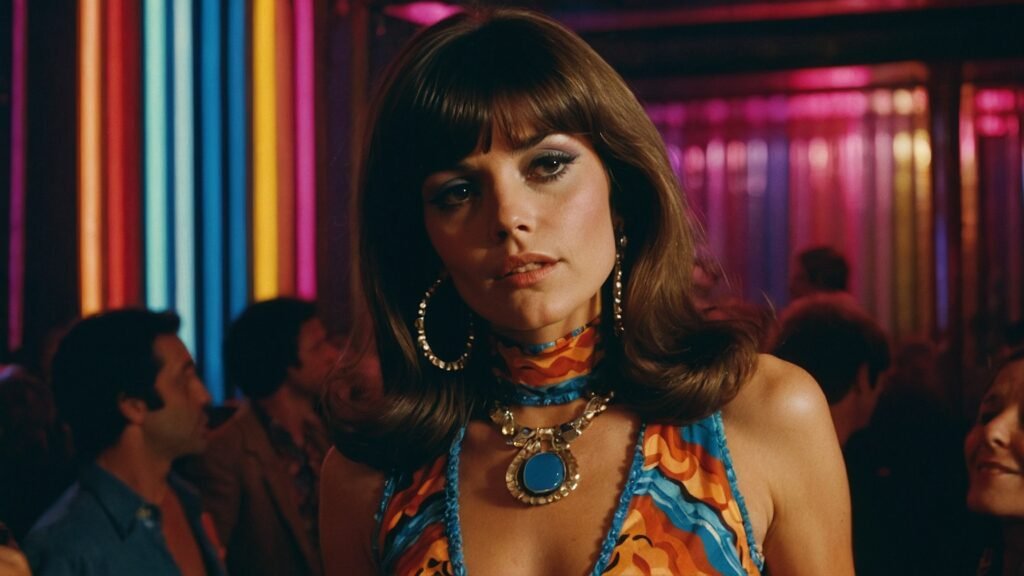
How has the disco era’s influence persisted in contemporary fashion, art, and pop culture?
The disco era’s vibrant colors and shimmering aesthetics continue to leave an indelible mark on contemporary fashion, art, and pop culture. Fashion designers have paid homage to the iconic era through bold color choices, shimmering textures, and disco-inspired styles.
Contemporary artists and designers draw inspiration from the vibrant colors and shimmering textures of the 70s, incorporating them into installations and interior design.
Pop culture and media also embrace disco fever, with television shows, movies, music videos, and live performances frequently drawing inspiration from the era’s unique style and cultural significance.
What is the significance of the disco era’s embrace of self-expression and individuality?
The disco era was a time when self-expression and individuality were celebrated through bold fashion choices and a carefree spirit.
The vibrant colors, shimmering textures, and daring styles of the period reflected a sense of freedom and a rejection of traditional norms.
This embrace of self-expression and individuality continues to resonate today, inspiring contemporary artists, designers, and fashion enthusiasts to embrace their unique identities and celebrate their creativity through their work and personal style.
How did the disco era’s influence extend beyond fashion and into other aspects of pop culture?
The disco era’s influence extended far beyond just fashion. The vibrant colors and shimmering aesthetics of the 70s permeated various aspects of popular culture, including art, music, and interior design.
Album covers and concert posters featured eye-catching designs with psychedelic patterns and neon hues, reflecting the energy of the disco music scene. Interior design celebrated opulence and glamour, with mirrored surfaces, plush velvet furnishings, and bold color schemes.
Even recreational venues like roller skating rinks and bowling alleys embraced the vibrant hues and shimmering accents of the time, creating havens for self-expression and celebration.
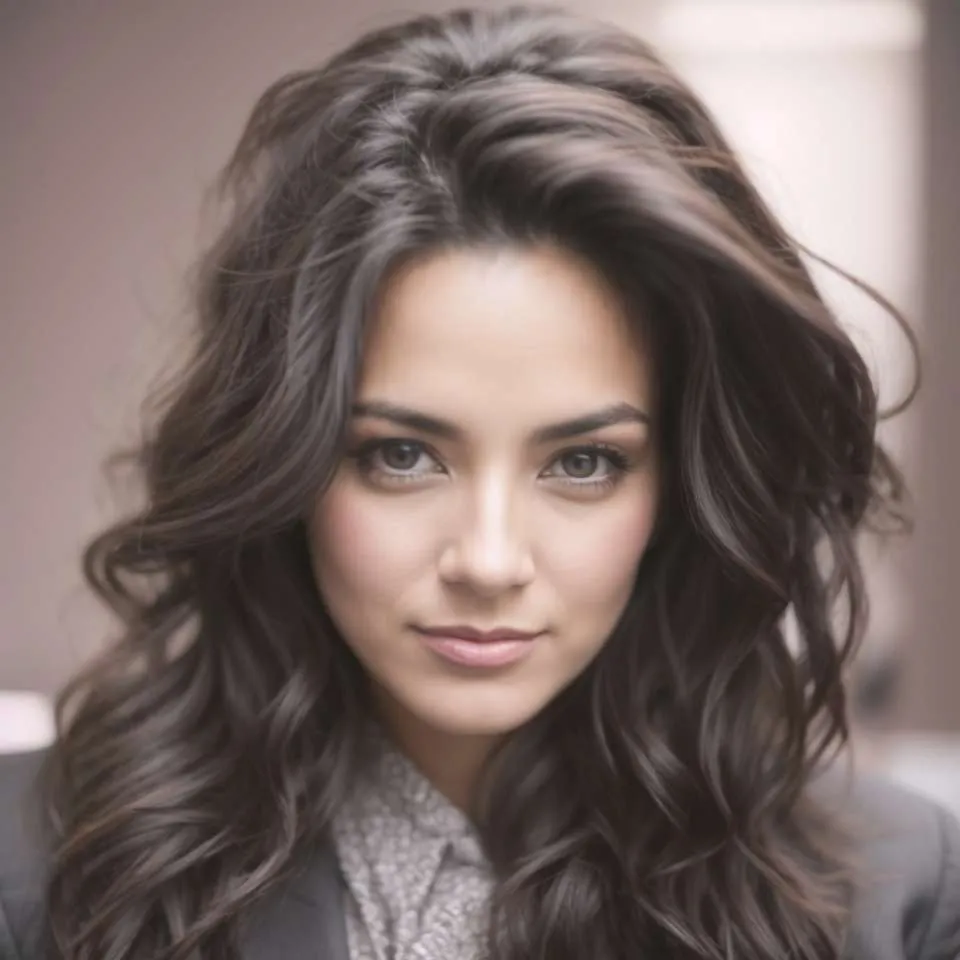
Gabrielle J. Smith is the pulsating essence that brings life to the world of fashion and color. With an innate talent for understanding the nuances of hues, she has the uncanny ability to paint narratives with her words, diving deep into the realm of color trends and the art of harmonizing them. Not just an expert in the field, Gabrielle also plays a pivotal role in strengthening the cohesion of our team, ensuring growth and harmony. Each of her articles is a testament to her passion, weaving captivating tales that resonate with readers and fashion aficionados alike.
Reviewed By: Joanna Perez and Anna West
Edited By: Lenny Terra
Fact Checked By: Matthew Mansour
Photos Taken or Curated By: Matthew Mansour

